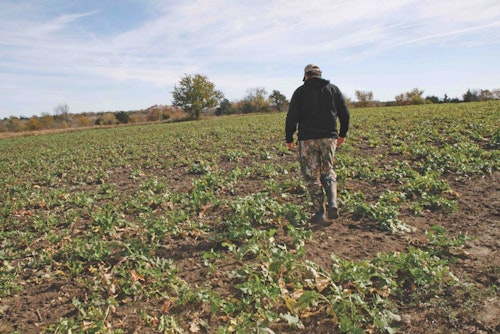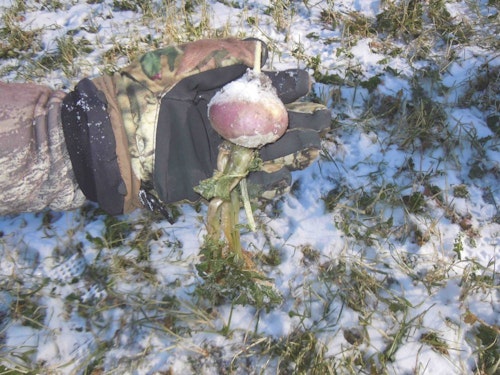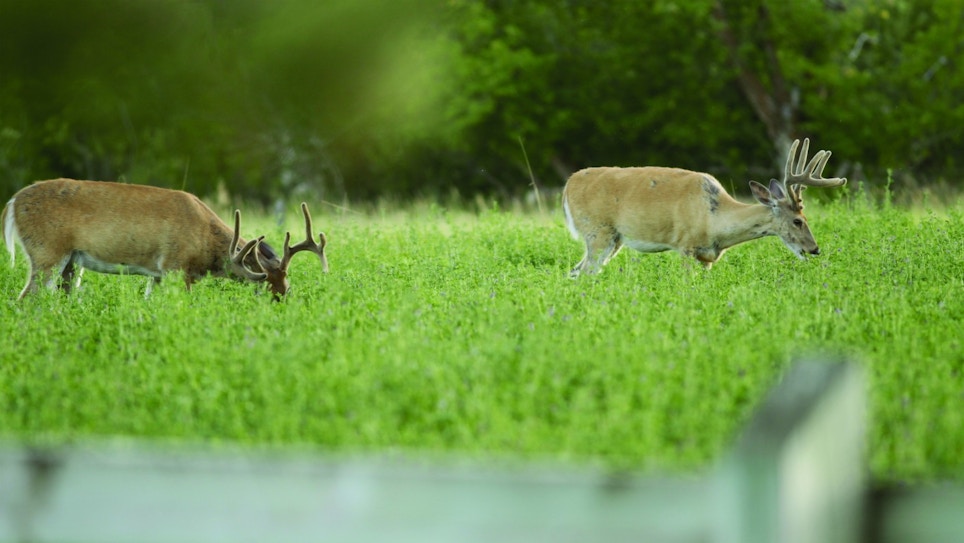You seldom sit down in a restaurant and order without reading a menu first. Even if you’re a regular your curiosity inspires a glimpse to see if anything new was added. Whitetails may not scan a menu in the same manner, but they definitely enjoy revisiting the best dining in the area. That’s why it’s vital you plan a great menu to attract repeat diners. Add to that importance is creating a menu, that when combined with native dishes, keeps drawing in whitetails 365 days a year.
Ryan Basinger serves as the wildlife consulting and hunting lease manager for Westervelt Wildlife Services. With more than 20 years of experience in whitetail property management and 35 years of whitetail hunting experience, Basinger understands the importance of planning a menu that whitetails will worship throughout the four seasons. Today, he consults across the entire range of whitetail deer to help clients meet their wildlife property goals. He wants to guarantee that no menu item is missing throughout the seasons.

“From a quality hunting standpoint, having quality food sources available on your property year-round is critical to ensure deer spend more time on your property rather than on neighboring tracts searching for seasonal food sources,” stresses Basinger. “This searching exposes bucks that you may be trying to protect or harvest yourself. Having quality, year-round food helps shrink home range size to maximize the amount of time spent on your property, which ultimately increases the likelihood of an encounter with one of your hit-list bucks.”
Cordell Turner operates Circle Cross Outfitters in southwest Iowa and northwest Missouri. Despite his boyish looks, Turner has a keen eye for managing whitetail habitat after growing up in a farming family. He uses this farming background to manicure hunting properties and help others on the path to an outstanding wildlife haven.
“It’s extremely important to have the necessary groceries on your property for a couple reasons including overall herd health first and foremost,” says Turner. “It also holds deer on your property. If a nutrition component is missing the deer will be more willing to travel to find what they need and your overall herd could potentially be impacted in a negative way.”
Hunting may be the pinnacle danger for wandering whitetails, but don’t overlook the hidden threats that deer face daily if they expand their search for the best nutrition. Basinger points out that odds increase of them becoming an insurant statistic in an automobile collision, they could face predator meetings and individual health risks increase.
“Overall health and fitness declines, which can lead to reduced body weight, poor antler quality, reduced fawning rates, as well as susceptibility to disease,” notes Basinger, describing the negatives of roaming whitetails.
The overall health of the herd is the end goal for Basinger and Turner. Quality, year-round nutrition helps the deer herd reach and maintain its highest potential. That helps bucks develop the best possible racks and it boosts consistent reproductive success for the does in the herd. When the menu is right throughout the seasons you’ll ultimately be a satisfied hunter.
Spring Fare
Although early spring can be testing for whitetails coming out of a harsh winter, once the landscape takes on a green glow whitetails can quickly boost their health status. Both native vegetation and planted food plots can provide a quick uplift that’s needed for whitetails to jumpstart antler growth, and to ensure fawn fetuses continue strong growth. For Basinger, naturally-occurring food sources play a vital role in this seasonal period.
“The primary component of a deer’s diet is forbs, which are broadleaf herbaceous plants, not grasses,” Basinger states. “During this time the lush, new growth is very palatable and nutritious in most regions of the country. The preferred species vary according to your region, but species like old field aster, beggar’s lice, greenbrier, pokeweed, common ragweed and blackberry are preferred species of whitetails across much of their range.”
Turner also inventories properties to see what Mother Nature will offer to secure an overall plan. He understands that even properties in his backyard can vary depending on their woodland or pasture makeup. Nevertheless, he looks for any fruit-bearing trees and whether ample shrubs, and saplings are available for deer to browse on buds. And although trees that have been hinge cut oftentimes are looked at as a winter food source, he views them as vitally important as deer wait for the spring surge of growth.
As native browse begins its green-up surge your food plots can also play an integral role in filling in any missing nutritional gaps, especially if your property lacks sufficient native browse. Of course, planted plot species only work if they have spring regenerative qualities with perennials as the main menu item.
“Overall, spring is generally not a nutritionally stressful time of year for deer because of the amount of food that is typically available after spring green up. However, with regard to planted crops that are available during the spring, the annual crops that are planted in the fall should be performing at a very high level during spring due to increases in temperature and day length,” says Basinger. “For optimal nutritional benefit plots have to be managed properly along the way through lime, fertilizer and weed management.”
Annual crops planted in the fall that Basinger sees as great boosters in the spring include cereal grains, crimson clover, arrowleaf clover, frosty berseem clover, fixation balansa clover, plus others. Perennial species, such as various white clovers and chicory, also perform well in the spring according to Basinger.

Summer Delights
Whitetails finally receive a chance to breathe easy as summer blossoms. Even so you need to be aware of influencers that can sway nutritional needs and whitetail wandering. That’s why Basinger stresses to evaluate environmental factors on your property. For instance, the amount of food available could be affected by habitat type such as closed-canopied woods that restrict sunlight versus more open habitats that promote sunlight to ground level. Basinger emphasizes that additional sunlight stimulates development of food and cover.
Weather factors can also manipulate nutrition and every year you face the same challenges as full-time farmers trying to grow commodities like Turner’s family. Plus, if you do get a bumper food plot your target market can strip it clean with speed.
“It also depends on the timing and amount of rainfall that drives development of vegetation communities, as well as the density of the deer herd that can also influence what is available through browsing pressure,” said Basinger. “In general, species will emerge and be available at different times, which is why species diversity is important. Once the forbs have been eaten up deer will shift to shrubs like sumac, vines such as wild grape and other woody browse that is within reach. Soft mast, such as blackberries and dewberries, also start becoming available.”
In Turner’s Iowa backyard summer becomes a sensory overload for most whitetails. He sees deer browsing on everything blooming with elms being a favorite, but deer definitely focus on the developing crops.
“You can’t ignore the fact that whitetails will seek out the large agricultural fields in the Midwest, including here in Iowa and Missouri,” Turner said. “Green soybeans, immature corn and other crops that offer supple, young leaves along with tasteful, young grains are hard to compete with in the summer.”
Some of your food plots will be maturing at this time of year while others could just be in the process of being planted. Scheduling your menu to match or supplement available native browse helps deer maintain health, and reduces the chance of a targeted food source being overused in the summer months. Browse, area croplands and your food plots make summer a good time to be a whitetail, but diversity allows everything to thrive.
Fall Foods
Although summer seems as food is in a never-ending supply, by late summer the menu could be challenged. It’s important to foresee this shifting situation to ensure deer don’t drift immediately before hunting season.
“By fall there typically isn’t much quality browse left unless late summer rains have promoted some new growth,” reveals Basinger. “Forbs are typically completely gone by fall or the late comers have bolted, and gone to seed which makes them much less attractive and palatable. There may be some shrubs and woody sprouts still holding on to some leaves that are still available, but by this time they have become hard, characterized by stems, less palatable and less attractive.”
If you’re fortunate to have mast on a property breathe a sigh of relief. In the fall, a deer’s diet shifts heavily to acorns and other soft mast as they mature. Basinger notes that land managers should also scout for persimmons and wild grape as bonus mast for a whitetail attraction. Your food plots should also be maturing and pay attention to surrounding agricultural crops as they can pull deer to new nutrition and change patterns overnight.
“You really have to invest in scouting in the fall as food options change,” Turner points out. “First and foremost harvested crop fields can be a magnet since spilt grain is easy to access. Your planted food plots, such as standing soybeans and standing corn are also attractive at this time of year. Alfalfa, winter wheat, turnips, and radishes are also alluring, but whitetail tastes can change making ongoing scouting so important. My ideal hunting plots in the fall contain alfalfa, standing corn and standing beans.”
As Turner noted, variety in your fall food plots helps draw deer in early to your property, hold them during hunting season and hopefully provide nutrition into the fall. That’s also Basinger’s goal while consulting with property managers. For an early-season attraction he recommends quick-growing cereal grains such as wheat, oats or triticale that germinate, and develop quickly. Other fast-growing options include clovers such as crimson, frosty berseem and balansa.
With the proper planning and planting any existing perennial clover, and chicory plots should also be producing well. As temperatures fall these will begin attracting deer says Basinger. Of course he advises everyone to consult with an expert to meet your specific objectives for individual plots. Soil types, regional moisture and deer density define when, and how much forage you need available.
Winter Grind
Regardless of whether your whitetail property resides in the wintry North or the dormant South, the winter menu options dwindle like pizza slices on all-you-can-eat buffet. This is when menu planning becomes critical. If your property has meager or no menu selections available it can force deer to migrate or worse … die. Fortunately there are solutions to the unavailability of menu favorites after hunting season.
“There’s not much for natural browse available after a couple hard frosts,” warns Basinger. “There are some species like honeysuckle that will stay green in the South, as well as species like blackberry that may be growing beneath the protective canopy of pine plantations that can provide forage. In the North having young hardwood saplings can be important to get deer through the harsh winter. Deer will also use acorns until they are depleted.”
Even though acorns can be a Godsend, Basinger has studied their production extensively and understands that acorn output varies annually. Some years are bumper crops while others produce very little. That’s why he emphasizes the need for a planned food plot program to overcome glitches like poor acorn years.
Turner highlights the option of corn and adds soybeans into the mix. Not only do they provide energy, but they have a positive characteristic land managers in the Snow Belt need to consider against other crop options.
“Soybeans and corn are the ideal options during winter. Both of these sustain winter weather well because they stay above the line of snowfall in my area. Clover is also welcome and provides nutrition because it stays green throughout a lot of the winter months. Unfortunately, it can be hard to access with deep snow.” To get the most bang from your property investment you need to play the role of a restaurant manager with a year-round mission. Plan a menu that meets the demands of area whitetails throughout the seasons and you’ll be rewarded during the one season that counts, the hunting season.

Sidebar: The Most Important Season
Deciding on which nutritional food source to provide and manage varies by region. Surprisingly, Basinger educates many property managers that the most stressful season also varies by region. It’s determined by the season that exposes deer to the most natural stress in a particular region. In the North, without question, winter can be the most stressful for whitetails.
“In general, this means late winter that includes heavy snow cover in the North and post-rut recovery through their range, but that changes as you move south,” he said. “In late summer the South is hot, dry and demanding. With fawning and lactation requirements, does in particular have high energy demands. Thus ensuring good nutrition during these times can bridge the gap until conditions improve.”
Consulting with a state biologist or a wildlife biologist consultant with a background like Basinger’s is essential for proper regional planning. Simply following a standard guideline could jeopardize fawn health in a southerly location or neglecting winter needs could jeopardize the life of rut-weary bucks in the North.
Photos by Mark Kayser






